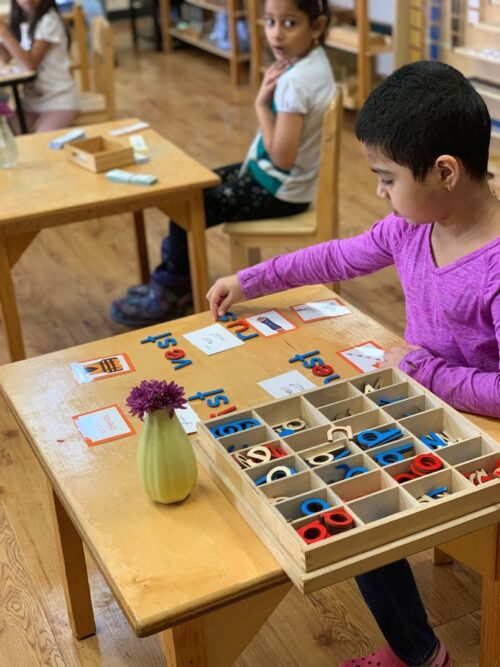
In our previous blogs we talked about work being the child’s play and what happens in the 2.5 to 3 hour work period. Today, we will talk about the classroom as a community of people, who work together in harmony.
The Role of Peers in the Mixed Age Community
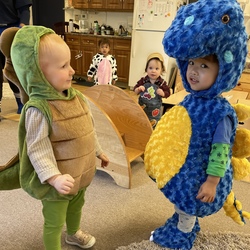
In traditional education, where children are in classes with same-age peers, the opportunity for peer-to-peer learning and leadership is limited. When the children in a class are the same age, the traditional system requires a teacher to “teach down” meaning they need to move the group as a whole. This generally allows the teacher to effectively meet the needs of about 60% of the classroom group. The rest of the group is either being pushed too fast in some areas while leaving others bored.
In the Montessori community, the ages are mixed on purpose.
The younger children look to the older children for guidance, mentorship. Think about the last time you tried to “teach” your child only to have them excited to learn the same thing from their older cousin? Young children strive to be like the children who are just a bit older.
The older children LOVE to help the younger children. This allows them to develop mastery! Think about it, if you can teach it, you likely have mastered it. The guides watch for this and observe the older children practicing mastery by helping the younger friends. This also helps to instill empathy, care, kindness. All the primary elements of a community of people.
Children move around the environment, choose where they work. This doesn’t mean they just plop their rug down in front of the door. The guide and the children talk about what works and what doesn’t work. For example, she might have a conversation with the whole group and talk about where to place the work rug and allow the children to talk about why it might not be a good idea to place a work rug in front of the door. What might happen? Well, if there is a fire drill, the rug would be in our way, when we line up. Someone might come in and not see the rug, and accidently kick my work, etc. They work together to solve problems, to ask questions and think through what is best for the community as a whole.
Work is Child Initiated
Children work at their own pace – the classroom community is rich with self-directed activities. The children develop confidence as they move about the environment, choosing work independently.
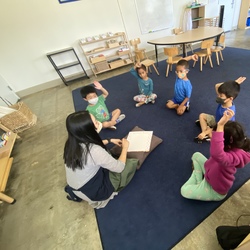
Young children naturally understand each other.
What does that mean? Children understand that everyone is not the same, some friends need more help than others, etc. Young children work together to help each other, they understand that everything does not have to be divided up evenly. They seem to naturally know that a community of people working together means there are differences.
For example, some children need longer to finish their lunch, some children have a very hard time waiting in line.
It is generally the adults that try to make everything “fair”. If you truly listen and observe young children, they can usually work this out, such that the whole community gets what they need.
This fosters the idea that a community of people working together, children naturally help each other. The Montessori classroom community is designed to allow them the space to safely do just that.
Role of the Guide
During the work period, you might find the guide sitting on the floor with a few children around – giving lessons both 1:1 and/or to small groups of children.
The rest of the children are free to choose work.
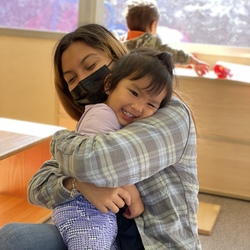
Because the activities are individual and have a particular location on the shelf (all at child level), many of the activities are self-correcting and children quickly pick up on the routine to take the activity to a table or rug and restore back to the shelf once finished. You will see children move with ease and even the new friends pick this up easily. This helps to establish confidence, independence and care for their environment. Another great way to establish “community”.
You might find the guide off to the side of the room, watching, observing.
A well-trained Montessori guide, grounded in Montessori philosophy can quickly scan a room and see what children are working on, how they are moving their bodies, working collaboratively or independently and determine what skills are being mastered. Right before her eyes.
Discipline in the Montessori Community
I had the opportunity to observe in a Montessori community and be close enough to hear the following interaction:
A child had some work out on a rug and was treating the material with disrespect. The guide got down to the child’s level and said:
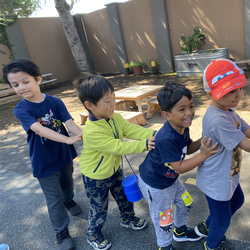
“Can I ask you a question?”
The child stopped and looked right in her eyes.
“Yes”
“Do you think you are setting a good example for our younger friends, working with the material this way?”
It was that simple, she ended up helping him put the work away and choose something else.
The children in the Montessori community are expected to become leaders and help others. We do this with care, kindness and respect.
Imagine if education as a whole were approached with establishing “community’, working together, helping each other. Our world might be a better place.
Walking the Line
If you ever have the chance to observe this activity in a Montessori classroom community, you are in for a real treat.
“Walk-the-Line” is one of the core ways for the Montessori classroom to develop their community. The purpose is to develop balance and coordination. However, is a wonderful example of how children independently work together to move in unison.
A true community of people working together.
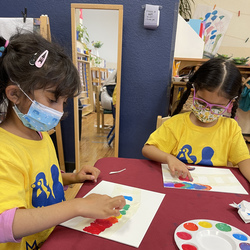
Typically, when the 2.5 to 3 hour work period ends, the children transition to walk the line with ease.
At the end of the work period, the guide will ring the chime.
The children put their work away or some might save larger work with a name tag. The work will sit undisturbed until the child returns to finish the work and put it away.
The guide changes the music (from morning classical music) to the Walk-the-Line music. In some cases, a guide might play the music on the piano.
Once a child has put away his work, he will “join” the line. The children will walk the line until everyone has put away their work and joined their friends on the line. Sometimes the guide joins the line or sometimes she might hand each child an object, to carry. Sometimes the children will walk the line without the guide.
As the music changes, the children naturally change the beat in which they are walking the line. The guide never speaks or corrects. The children naturally follow the older children who know the rhythm and they follow along.
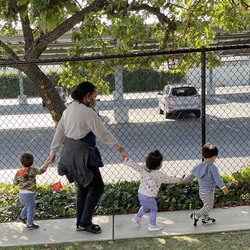
The consistency of this daily exercise helps to establish the working community of the group. The children enjoy this activity. Observing the children during the walk the line activity allows the guide to observe each child’s large and smaller motor skills. The most often asked question “How can one guide possibly know where each child is individually?” Well, this is one way. Each day the guide will observe the line and notice the skills of the children as they continue to develop coordination. She will make a mental note or even a quick written note. At MSOSV the Montessori guides use an online record keeping system to easily track progress of their children. Progress is tracked every day.
Some of the different movements in the walk the line activity include:
Once the music stops, the children either go get their lunch or sit on the line for a short group circle time.
These are just a few examples of what goes on inside a Montessori community. We invite you to schedule an observation at one of our five campus locations and come to see for yourself.
Montessori and Classroom Communities
The Role of the Guide: How They Can Follow Each Child Independently – Allowing Each Child to Learn and Grow at Their Own Pace